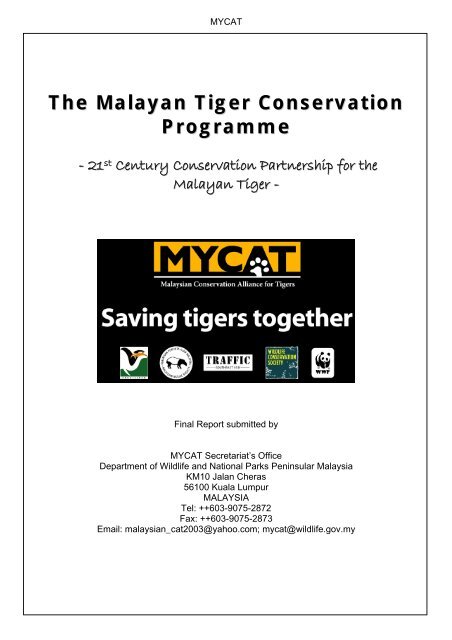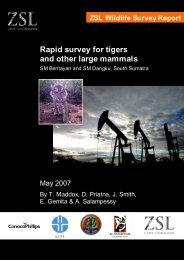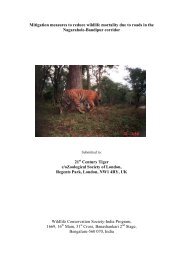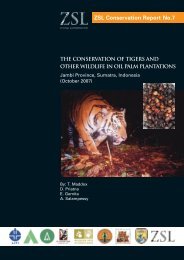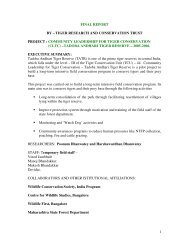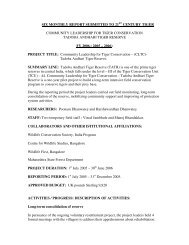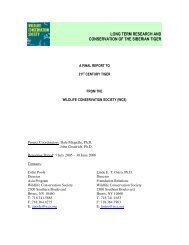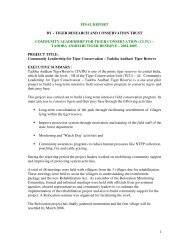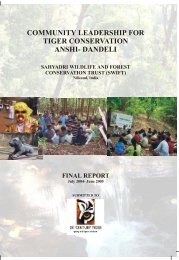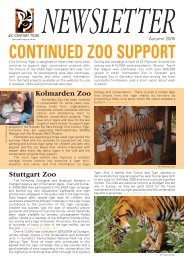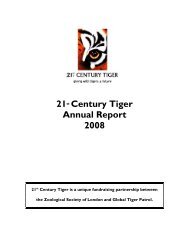MYCAT final report 2006-07 - 21st Century Tiger
MYCAT final report 2006-07 - 21st Century Tiger
MYCAT final report 2006-07 - 21st Century Tiger
You also want an ePaper? Increase the reach of your titles
YUMPU automatically turns print PDFs into web optimized ePapers that Google loves.
<strong>MYCAT</strong><br />
The Malayan <strong>Tiger</strong> Conservation<br />
Programme<br />
- 21 st <strong>Century</strong> Conservation Partnership for the<br />
Malayan <strong>Tiger</strong> -<br />
Final Report submitted by<br />
<strong>MYCAT</strong> Secretariat’s Office<br />
Department of Wildlife and National Parks Peninsular Malaysia<br />
KM10 Jalan Cheras<br />
56100 Kuala Lumpur<br />
MALAYSIA<br />
Tel: ++603-9<strong>07</strong>5-2872<br />
Fax: ++603-9<strong>07</strong>5-2873<br />
Email: malaysian_cat2003@yahoo.com; mycat@wildlife.gov.my
Introduction<br />
Thirty years have passed since the tiger was listed as a totally protected species in<br />
Malaysia under the Protection of Wild Life Act in 1976. Malaysia is one of 13 nations<br />
where the tiger clings for survival today. Throughout its range, the species lost 93%<br />
of its original habitat and three subspecies in the past century (Dinerstein et al.<br />
<strong>2006</strong>). In the past decade alone, tiger habitats in India, Indochina and Southeast<br />
Asia shrunk by 40%. Threats to the survival of wild tigers are mounting and the world<br />
without tigers may become a reality in our lifetime.<br />
Challenges to tiger conservation are multi-faceted. Finding solutions therefore<br />
requires an integrated conservation approach. As the leading government agency in<br />
wildlife conservation in Malaysia, one of the critical roles of the Department of<br />
Wildlife and National Parks Peninsular Malaysia (DWNP) is to promote the<br />
integration of and collaboration with conservation partners in reaching the goal of<br />
conservation excellence.<br />
In the overarching spirit of partnership, the DWNP initiated the Malaysian<br />
Conservation Alliance for <strong>Tiger</strong>s (<strong>MYCAT</strong>) in 2003. <strong>MYCAT</strong> is a formal yet flexible<br />
platform for information exchange, collaboration, and resource consolidation among<br />
the conservation partners. The current partner organizations are the Department of<br />
Wildlife and National Parks Peninsular Malaysia (DWNP), the Malaysian Nature<br />
Society (MNS), TRAFFIC Southeast Asia (TSEA), the Wildlife Conservation Society<br />
(WCS) and WWF-Malaysia.<br />
The goal of the Malayan <strong>Tiger</strong> Conservation Programme is to strengthen tiger<br />
conservation in Malaysia by enhancing public awareness levels on tiger<br />
conservation-related issues and by forging greater partnership through increased<br />
communication and collaboration with <strong>MYCAT</strong> partners, the public, other<br />
government agencies, members of the private sector and zoos.<br />
This project aimed to support four areas identified in <strong>2006</strong> by <strong>MYCAT</strong> as immediate<br />
priorities.<br />
1. Reduction in local consumption and trafficking of tigers and tiger prey<br />
through targeted campaigns. A series of targeted campaigns focused on<br />
reducing consumption of traditional tiger medicine and meat of both tigers and<br />
tiger prey as a delicacy, and local trafficking and poaching of tigers and their<br />
prey nationwide.<br />
2. Drawing roadmaps to secure the future of the Malayan <strong>Tiger</strong>. By<br />
consolidating expertise, <strong>MYCAT</strong> collaboratively produced the National <strong>Tiger</strong><br />
Action Plan for Malaysia to provide direction and specific actions required to<br />
ensure the survival of the Malayan tiger into the next century.<br />
3. Building local support and cultivating conservation-minded Malaysians<br />
through awareness programmes in zoos. <strong>MYCAT</strong> developed and<br />
implemented tiger-themed events and permanent displays in the National Zoo<br />
to raise awareness and support for tiger conservation.<br />
4. Maintain and expand conservation partnerships. <strong>MYCAT</strong> maintained the<br />
platform for increased communication among the current and future partners
<strong>MYCAT</strong><br />
for better coordination and collaboration in tiger conservation to disseminate<br />
and consolidated information to the public to raise awareness and support.<br />
This document <strong>report</strong>s the accomplishments in respect to the second objective that<br />
was financially supported by 21 st <strong>Century</strong> <strong>Tiger</strong>. For information on other objectives,<br />
refer to the supplemental information, <strong>MYCAT</strong> TRACKS <strong>2006</strong>-20<strong>07</strong> at the end of this<br />
document.<br />
Malayan <strong>Tiger</strong> Conservation Workshop<br />
Using the collaborative <strong>MYCAT</strong> platform, DWNP, together with <strong>MYCAT</strong> NGO<br />
partners held the Malayan <strong>Tiger</strong> Conservation Workshop in November <strong>2006</strong>. The<br />
objective of the workshop was to develop the National <strong>Tiger</strong> Action Plan for Malaysia<br />
(hereafter the Plan) reflecting national needs and local capacity in line with existing<br />
national policies relevant to tiger conservation.<br />
The workshop was officiated by the Deputy Undersecretary of the Conservation and<br />
Environmental Management Division of the Ministry of Natural Resources and<br />
Environment (MoNRE). Representatives from key stakeholders participated in the<br />
workshop, including senior officials from the DWNP, Department of Forestry,<br />
Department of Town and Country Planning, Public Works Department, Interpol,<br />
Johor National Parks Corporation, Perak State Park Corporation, and Federation of<br />
Chinese Physicians and Medicine Dealers Association of Malaysia.<br />
3
<strong>MYCAT</strong><br />
Speeches by the Deputy Undersecretary of MoNRE and Director General of DWNP<br />
commemorated the three decades of total protection of the tiger in Malaysia and<br />
provided the participants with Malaysia’s vision for tiger conservation. A press<br />
conference and articles on the event were carried by several local newspapers<br />
(Appendix 1) and featured in MNS’ monthly newsletter, Pencinta Alam (Appendix 2).<br />
The programme then moved on to a series of targeted presentations and panel<br />
discussions that addressed major threats to tigers.<br />
Foundations for the workshop were laid two months prior to the workshop, where<br />
<strong>MYCAT</strong> conducted a threat assessment for tigers in Malaysia and discussed the<br />
goals of tiger conservation through a series of Working Group meetings. The<br />
presentation on the results of the assessment and the proposed goals and objectives<br />
set the scene and led the participants into the subsequent group discussions on<br />
quantitative indicators and specific actions to reach the collective goals.<br />
As some of the actions to mitigate the threats to tigers are beyond the jurisdiction of<br />
the wildlife conservation agencies, the panel discussions and subsequent group<br />
discussions involved decision-makers from other relevant government agencies and<br />
stakeholders. The presentations and discussions were held in both English and<br />
Bahasa Malaysia, Malaysia’s national language, to ensure maximum participation<br />
from all the participants.<br />
The following is the programme of the workshop.<br />
7 Nov <strong>2006</strong><br />
Topic Presenter<br />
Opening speech<br />
Dr Nadzri Yahya<br />
Malaysia’s vision for the Malayan <strong>Tiger</strong> Deputy Undersecretary<br />
Conservation and Environmental<br />
Management Division<br />
Ministry of Natural Resources and<br />
Environment<br />
Introduction to the workshop Mr Rasid Samsudin<br />
Expectations and outputs<br />
Director General<br />
Department of Wildlife and National Parks<br />
Malaysia in global tiger conservation Dr John Seidensticker<br />
efforts<br />
Chairman<br />
Significance of Malaysia and<br />
Save the <strong>Tiger</strong> Fund Council<br />
international funding mechanisms for Scientist and Head,<br />
tiger conservation efforts worldwide Conservation Ecology Center,<br />
Smithsonian's National Zoological Park<br />
Where we are and where we want to Dr Kae Kawanishi<br />
go?<br />
Secretariat<br />
Focused action plan using a holistic<br />
and integrated approach<br />
Malaysian Conservation Alliance for <strong>Tiger</strong>s<br />
<strong>Tiger</strong> Management Plan and<br />
priorities<br />
Mr Kadir Hashim<br />
Principal Assistant Director<br />
4
<strong>MYCAT</strong><br />
Biodiversity Conservation Division<br />
Department of Wildlife and National Parks<br />
Role of NGOs in tiger conservation Ms Kanitha Krishnasamy<br />
Science Officer<br />
Science and Conservation<br />
Capacity building, community<br />
outreach and awareness<br />
programmes<br />
Panel Discussion 1: Implementation<br />
of National Physical Plan<br />
a. Implementation, enforcement and<br />
monitoring of National Physical Plan<br />
(NPP. 18 and 19)<br />
b. What it means to tigers, challenges<br />
and possible resolutions<br />
c. Discussion<br />
d. Resolutions<br />
Panel Discussion 2: Combating the<br />
tiger trade<br />
a. Specific trade-related threats to<br />
tigers in Malaysia<br />
b. Current mitigation measures, plans<br />
and recommendations for the future<br />
c. Discussion<br />
d. Resolutions<br />
Panel Discussion 3: Human-<strong>Tiger</strong><br />
Conflict as a result of unsustainable<br />
rural development<br />
a. Current status, mitigation measures<br />
and recommendations for the future<br />
b. Resolutions from Human-wildlife<br />
Conflict Mitigation Workshop in July<br />
<strong>2006</strong><br />
c. Discussion<br />
d. Resolutions<br />
8 Nov <strong>2006</strong><br />
Recap of the previous day<br />
Finalise the goals and priorities<br />
Briefing on the group discussions<br />
Group discussions on action plan<br />
Progress <strong>report</strong> on discussions<br />
Malaysian Nature Society<br />
Dr Melvin Gumal<br />
Malaysia Programme Director<br />
Wildlife Conservation Society-Malaysia<br />
Ms Siow Suan Neo<br />
Deputy Director<br />
National Physical Plan Division<br />
Department of Town and Country Planning<br />
Mr Brian Lee<br />
<strong>Tiger</strong> Project Leader<br />
WWF-Malaysia<br />
Mr Chris R. Shepherd<br />
Senior Programme Officer<br />
TRAFFIC Southeast Asia<br />
Ms Misliah Mohd Basir<br />
Director<br />
Law & Enforcement Division<br />
Department of Wildlife and National Parks<br />
Mr Salman Saaban<br />
Senior Assistant Director<br />
Biodiversity Conservation Division,<br />
Department of Wildlife and National Parks<br />
Mr Ahmad Zafir Abd Wahab<br />
<strong>Tiger</strong> Team Scientific Officer<br />
WWF-Malaysia<br />
5
Q & A / Discussion<br />
<strong>MYCAT</strong><br />
9 Nov <strong>2006</strong><br />
Group discussions<br />
Revision of plans based on suggestions from other groups<br />
Finalising the <strong>Tiger</strong> Action Plan<br />
Commitment<br />
Final presentation by groups<br />
Q & A<br />
Closing<br />
<strong>Tiger</strong> Action Plan<br />
All decisions reached and plans discussed during the workshop formed the first,<br />
rough draft of the Plan. At the 10 th <strong>MYCAT</strong> Working Group meeting on the 21 st of<br />
November <strong>2006</strong>, the drafting committee, comprising selected members of the<br />
<strong>MYCAT</strong> Working Group, was formed to shoulder the task of drafting the Plan.<br />
The Plan is the culmination of the joint efforts of all interested parties involved in tiger<br />
conservation in Malaysia. Besides numerous telephone and online discussions, the<br />
drafting committee met 17 times between November <strong>2006</strong> and July 20<strong>07</strong> to review<br />
and improve the Plan, which underwent 11 revisions before submission to the<br />
DWNP <strong>Tiger</strong> Action Plan Advisory Board, comprising DWNP senior officials and<br />
headed by the DWNP Director General, in August 20<strong>07</strong>. The Plan was presented to<br />
the Advisory Board by the <strong>MYCAT</strong> Secretariat’s Office in September 20<strong>07</strong> and<br />
subsequently the Board met four times to further improve the Plan. After this internal<br />
draft (the 12 th draft) was <strong>final</strong>ised, it was made available on the DWNP website for<br />
open public review for 2 weeks in December 20<strong>07</strong>. After the public review and<br />
comments, the 13 th draft was submitted to the two major stakeholders in the<br />
government, namely the Forestry Department and Department of Town and Country<br />
Planning Department (DTCP) in January 2008 for their review, as well as to solidify<br />
the relationship towards successful implementation of actions where these agencies<br />
are involved. Revisions made by DTCP were received and incorporated in March.<br />
Due to the general election that occurred in March, there was a major delay in<br />
receiving a response from the Forestry Department. As their full support of the Plan<br />
is vital, we allowed a period of time for the post-election government to settle in, and<br />
we managed to communicate with the Forestry Department, and received full<br />
support of the Plan, with some minor changes incorporated, in April. With that, the<br />
Director General of DWNP submitted the 15 th and <strong>final</strong> draft to the MoNRE in May<br />
and the Minister <strong>final</strong>ly endorsed the Plan at the end of June. The Plan will be<br />
published by the third quarter of 2008.<br />
The aim of the Plan is to establish a holistic but focused and achievable conservation<br />
strategy that lays out specific actions to be taken over the next eight years (Phase I:<br />
2008-15) towards the common vision of securing viable tiger populations in Malaysia<br />
for the next century and beyond. In essence, the Plan functions as the work plan for<br />
<strong>MYCAT</strong> for the period of 2008 to 2015. Through this plan, the Malaysian government<br />
has the opportunity to present healthy tiger populations as an exemplar of its ongoing<br />
efforts to develop economically in a sustainable manner rather than the<br />
Malayan tiger becoming another symbol of the systematic loss of tropical forest and<br />
6
an ecosystem in crisis.<br />
<strong>MYCAT</strong><br />
The National Physical Plan (NPP) is the blueprint for spatial planning in Peninsular<br />
Malaysia and, therefore, provides the backbone for the Plan’s aspiration to secure a<br />
large expanse of interconnected tiger habitat, defined as the Central Forest Spine<br />
(CFS) in the NPP. Envisioned for realisation by 2020, the CFS is a network of forest<br />
complexes connected by green linkages that, together, form a contiguous forest<br />
spine for Peninsular Malaysia. Permanent Reserved Forests within the CFS provide<br />
critical habitat and connectivity to core tiger populations in the priority areas and<br />
buffer them from anthropogenic and natural demographic fluctuations. PRFs still<br />
contribute to the nation’s economic drive, where ecologically sound land-use<br />
practices such as eco-tourism and sustainable forestry are permitted. This is vital for<br />
the nation and the tiger because the large forest ecosystems that the tiger needs to<br />
thrive are also a primary source of the resources upon which human livelihoods<br />
depend. The presence of healthy tiger populations across the CFS will signify the<br />
balanced progression of the country’s ecology, society, culture and economy and,<br />
ultimately, an enhancement of the quality of life of Malaysians.<br />
The goal for 2020 identified in this National <strong>Tiger</strong> Action Plan for Malaysia is:<br />
<strong>Tiger</strong> populations actively managed at carrying capacities across the three<br />
landscapes within the Central Forest Spine and connected with functioning<br />
corridors.<br />
This Plan identifies four objectives towards achieving this goal:<br />
1. Secure the Central Forest Spine with strictly protected priority areas in<br />
landscapes connected with corridors.<br />
2. Provide effective and long-term protection of tigers and their prey.<br />
3. Promote and practice ecologically sound land-use, compatible with tiger<br />
conservation outside the priority areas.<br />
4. Apply science in monitoring the efficacy of conservation actions and improving<br />
the knowledge of tiger ecology.<br />
This Plan further outlines priority outcomes for each of the objectives and then<br />
translates these conservation objectives and desirable outcomes into concrete<br />
actions, responsible agencies, measurable indicators and realistic time-frames.<br />
These details lay out the first phase of the Plan to be carried out between 2008 and<br />
2015; dates that deliberately coincide with the 9 th and 10 th Malaysian Plan.<br />
In this Plan the importance of accountability and transparency in conservation<br />
actions is implicit, with an in-built evaluation and learning mechanism for a continued<br />
process of implementation. The overall indicator of success, or the Plan’s<br />
measurable target, is:<br />
About 1,000 wild tigers surviving on wild prey in the Central Forest Spine by the<br />
year 2020.<br />
The success of this conservation strategy must be reflected in the known status of<br />
the distribution and density of the tiger populations in Malaysia. In order to use these<br />
7
<strong>MYCAT</strong><br />
indicators, we must first establish a base-line upon which we can monitor our efforts<br />
to stabilise, increase and manage tiger numbers. By doing this, we hold ourselves<br />
accountable to the wild tigers for which this Plan is devised; the importance of<br />
conservation science, the fourth objective of the plan, becomes imperative. Applying<br />
scientific methods to measure the efficacy of conservation actions allows for the<br />
efficient planning of, allocation of resources to, and the implementation of specific<br />
activities. This increases the accountability and transparency in the conservation<br />
actions taken.<br />
By using an adaptive management approach to implement the Plan, the agencies<br />
involved can ensure a process that is both proactive and reactive, allowing lessons<br />
to be learned and new knowledge and methods to be incorporated as the work<br />
evolves. As such, it is a living document. This Plan is a collection of working models,<br />
strengthened through stakeholder dialogues, tested in practice, and constantly<br />
reviewed and revised. In order for real and mutual accountability and learning to take<br />
place, the core of the stakeholder engagement strategy must involve a two-way<br />
mechanism (dialogues). Here, responsible agencies and individuals will be actively<br />
encouraged to exchange views, clarify expectations, address differences, enhance<br />
understanding and encourage creative and practical solutions. <strong>MYCAT</strong> will continue<br />
to provide the necessary platform for the dialogues and learning.<br />
Acknowledgements<br />
This project would not have been possible without the generous financial support<br />
given by the 21 st <strong>Century</strong> <strong>Tiger</strong>, a programme of the Zoological Society of London<br />
Additionally, <strong>MYCAT</strong> received in-kind and monetary contributions from all the<br />
<strong>MYCAT</strong> partners towards the workshop. WWF-Malaysia financially supported the<br />
action plan drafting team leader for 6 months between <strong>2006</strong> and 20<strong>07</strong>. The <strong>MYCAT</strong><br />
Secretariat’s Office has received financial support from the US Fish and Wildlife<br />
Service for administration, communication and execution of joint projects for <strong>2006</strong>-<br />
20<strong>07</strong> and from the Save the <strong>Tiger</strong> Fund for 2008.<br />
Many thanks to all who made contribution towards developing this <strong>Tiger</strong> Action Plan<br />
that will lead all of us to a future in which tigers thrive in Malaysia.<br />
Reference<br />
Dinerstein, E., Loucks, C. Heydlauff, A., Wikramanayake, E., Bryja, G., Forrest, J.,<br />
Ginsberg, J., Klenzendorf, S., Leimgruber, P., O’Brien, T., Sanderson, E.,<br />
Seidensticker, J. and Songer, M. <strong>2006</strong>. Setting Priorities for the Conservation and<br />
Recovery of Wild <strong>Tiger</strong>s: 2005-2015 : A User's Guide. WWF, WCS, Smithsonian,<br />
and NFWF-STF, Washington, D.C. – New York.<br />
List of Appendix<br />
Appendix 1. Media coverage of the workshop<br />
Appendix 2. MNS newsletter, Pencinta Alam, <strong>report</strong>ing the workshop<br />
Appendix 3: <strong>MYCAT</strong> TRACKS <strong>report</strong>ing accomplishments of other objectives<br />
8
Cover Story: Let the beast prosper<br />
By SAM CHEONG<br />
15 November, <strong>2006</strong><br />
If the Malayan <strong>Tiger</strong> is to continue to survive, the public must play its part, writes SAM CHEONG, who<br />
was at the recent <strong>Tiger</strong> Conservation Workshop held in Pahang. IF there is a place where the Malayan<br />
<strong>Tiger</strong> (genus Pantera Tigris) can “live long and prosper”, it has to be in our very own jungles. Despite<br />
being threatened by illegal poaching and human conflict in its natural habitat, our nation’s largest cat<br />
specie still has a stable population in the wild.<br />
This can be attributed to more than 30 years of conservation work by the Government as well as the<br />
direct involvement of non-governmental organisations like the Worldwide Fund for Nature (WWF).<br />
Researcher Kae Kawanishi, who specialises in the Malayan tiger, predicts that the number of tigers in<br />
the wild will actually increase if their conservation area remains protected from human intrusion and<br />
poachers.<br />
She added that there is an estimated 500<br />
to 1,100 cats in the wild based on data<br />
collected by remote monitoring work<br />
carried out by organisations like WWF and<br />
the Department of Wildlife.<br />
“The highest concentration of tigers is<br />
around Perak, Pahang, Terengganu and<br />
Kelantan where conservation areas like<br />
Belum-Temenggor and Taman Negara are<br />
located,” she explained.<br />
Kawanishi was speaking at the first <strong>Tiger</strong><br />
Conservation Workshop in the Wildlife<br />
Department’s Bio-Diversity training centre<br />
in Lanchang, Pahang.<br />
Save The <strong>Tiger</strong> Fund spokesman John Seidensticker said the tiger population in Peninsular Malaysia is<br />
remarkable despite the great pressures brought about by the destruction of its natural habitat and<br />
conflicts with humans.<br />
Commenting on the long-term action plan on the conservation of the Malayan tiger, Wildlife Department<br />
Director Rashid Shamsudin said the Malaysian Conservation Alliance for <strong>Tiger</strong>s (<strong>MYCAT</strong>) will make the<br />
necessary recommendations to the Government.<br />
“Efforts to raise awareness among the public is ongoing and I urge people who have information about<br />
illegal poaching of tigers to get in touch with us so that immediate action can be taken,” he said.<br />
The department’s Director of Law Enforcement Misliah Mohd Bashir said around one case of illegal
harvesting of tigers and its parts is <strong>report</strong>ed annually.<br />
“This is based on official statistics from enforcement activities throughout the Peninsular. The department<br />
has also carried out joint operations with the army to flush out foreign poachers.<br />
“Since 2002, we have apprehended more than 75 people, mostly foreigners, for illegal poaching. They<br />
have been charged in court under the Wildlife Protection Act and Immigration Act.”<br />
Misliah added that the street price for a tiger is estimated at RM60,000 per carcass. Its body parts and<br />
organs are harvested and sold in China where the value is based on the foreign exchange.<br />
© Copyright <strong>2006</strong> The New Straits Times Press (M) Berhad. All rights reserved.
Malaysian Conservation Alliance for <strong>Tiger</strong>s (<strong>MYCAT</strong>) is the alliance of governmental and non-governmental organisations committed to saving the Malayan <strong>Tiger</strong><br />
Since its formation in 2003 <strong>MYCAT</strong> has been<br />
chaired by the Director General of the<br />
Department of Wildlife and National Parks<br />
Peninsular Malaysia (DWNP), also the<br />
agency that hosts the coalition’s<br />
Secretariat’s Office (<strong>MYCAT</strong> SO). The<br />
remaining <strong>MYCAT</strong> partners are the<br />
Malaysian Nature Society (MNS), TRAFFIC<br />
Southeast Asia (TSEA), Wildlife Conservation<br />
Society (WCS) and WWF-Malaysia.<br />
<strong>MYCAT</strong>’s vision is a Malaysia in which tigers<br />
thrive in perpetuity. To achieve this vision<br />
<strong>MYCAT</strong> provides a platform for dialogue,<br />
collaboration and resource consolidation<br />
among partners. <strong>MYCAT</strong> SO facilitates<br />
communication among the partners and<br />
coordinates joint projects.<br />
<strong>MYCAT</strong>’s objectives<br />
© Chris R. Shepherd / TSEA<br />
1. Secure the Central Forest Spine (51,000km² of<br />
contiguous forests) with protected core areas linked<br />
within the greater landscape by ecological corridors.<br />
2. Provide effective protection for tigers and their prey<br />
from poaching and trade.<br />
3. Promote the practice of ecologically sound land-use,<br />
compatible with tiger conservation.<br />
4. Apply sound science in monitoring the efficacy of<br />
conservation actions and improving the knowledge<br />
of tiger ecology.<br />
<strong>2006</strong> - 20<strong>07</strong><br />
This newsletter highlights the milestones<br />
achieved under the various <strong>MYCAT</strong> joint<br />
projects as well as those achieved by<br />
individual <strong>MYCAT</strong> partners in various<br />
tiger-focused conservation efforts in<br />
<strong>2006</strong> and 20<strong>07</strong>.
<strong>MYCAT</strong><br />
MILESTONES<br />
In November <strong>2006</strong>, DWNP in collaboration with other <strong>MYCAT</strong><br />
partners organised a workshop involving many government<br />
agencies, NGOs and individual contributors. The aim of the<br />
workshop was to develop a National <strong>Tiger</strong> Action Plan for<br />
Malaysia that would consolidate current knowledge and<br />
conservation strategies relevant to the Malayan tiger.<br />
The plan identifies specific actions to be carried out between<br />
2008 - 2015 as a foundation for achieving the 2020 target of<br />
1,000 wild tigers living, with sufficient wild prey, in the Central<br />
Forest Spine, which is the backbone of Peninsular Malaysia’s<br />
environmentally sensitive area network.<br />
Following extensive work by the <strong>MYCAT</strong> drafting team in<br />
consultation with the wider <strong>MYCAT</strong> community, the plan is<br />
currently awaiting its <strong>final</strong> endorsement by the Ministry of<br />
Natural Resources and Environment. Once ratified, it will be<br />
officially launched in 2008.<br />
To cultivate and nurture conservation-minded Malaysians,<br />
<strong>MYCAT</strong> SO conducted 11 extension programmes involving<br />
presentations, activities and interactive booths. The<br />
programmes, which reached out to almost 3,000 adults and<br />
children, were produced based on information consolidated<br />
from <strong>MYCAT</strong> partners.<br />
During the course of these programmes, volunteer<br />
opportunities were provided to 200 individuals, many of<br />
whom have since indicated either their intention to continue<br />
The Campaign<br />
The early months of 20<strong>07</strong> saw the start of <strong>MYCAT</strong>’s<br />
campaign to reduce local consumption of trade in tigers<br />
and tigers’ prey. By mid-20<strong>07</strong> outreach programmes were<br />
conducted in two well-known wildmeat trade hotspots;<br />
Kampung Punan and Kahang in Johor.<br />
> Reports on pages 3 & 4.<br />
2 <strong>MYCAT</strong> Tracks <strong>2006</strong>-20<strong>07</strong><br />
volunteering for conservation or their keenness to explore<br />
the potential of pursuing careers in conservation. <strong>MYCAT</strong><br />
hopes to expand this programme to provide them and<br />
others with more opportunities and training.<br />
To raise greater consciousness and encourage the public<br />
to take positive action for the tiger, <strong>MYCAT</strong> works closely<br />
with the media and continues to use the <strong>MYCAT</strong> e-group<br />
at http://groups.yahoo.com/group/malaysian_cat/ to<br />
keep subscribers updated on global and local<br />
tiger-related news. The e-group also provides a platform<br />
to engage subscribers and partners alike in active<br />
discussions on tiger issues such as China’s controversial<br />
attempts to legalise their domestic tiger trade. The<br />
monthly average e-traffic increased from 44 in 2005 to 75<br />
in 20<strong>07</strong>.<br />
Important issues continue to be highlighted in the <strong>MYCAT</strong><br />
Watch column provided by MNS in their monthly national<br />
newsletter, Pencinta Alam, and quarterly magazine,<br />
Malaysian Naturalist. A number of educational materials<br />
were produced and used in extension programmes and<br />
distributed for conservation education purposes.<br />
© Artwork by Yang Xin Ni ( )<br />
STOP STOP THE THE KILLING!<br />
KILLING!<br />
SMS SMS the the <strong>Tiger</strong> <strong>Tiger</strong> Crime Crime Hotline Hotline at at 019 019 356 356 4194 4194<br />
In December, the <strong>Tiger</strong> Crime Hotline was launched by<br />
celebrity <strong>Tiger</strong> Ambassadors during an urban outreach<br />
event - Race Against Time. The purpose of the 24-hour<br />
hotline is to encourage the public to <strong>report</strong> accurate and<br />
timely information on suspected tiger-related crimes.<br />
Reports received are instantly channelled to DWNP’s Law<br />
and Enforcement division for action. The <strong>Tiger</strong> Ambassadors<br />
also launched a signature petition campaign to push for<br />
improved wildlife legislation.<br />
> Report on page 5.
© <strong>MYCAT</strong><br />
Comprising about 300 villagers, Kampung<br />
Punan is one of several Orang Asli villages<br />
in the surrounding area of Endau-Rompin.<br />
eight school staff. Shy and anxious at first, the children soon warmed up, and actively participated in the interactive<br />
sessions. The day drew to a close with the students making pledges to protect the wildlife in Endau-Rompin. They wrote<br />
their oaths on cut-outs of various animals and stuck them on a banner, now displayed in the school as a reminder of their<br />
commitment to the wildlife of Endau-Rompin.<br />
© <strong>MYCAT</strong><br />
Students mapping their own territory in<br />
their village, to better understand the<br />
importance of a tiger’s territory.<br />
© <strong>MYCAT</strong><br />
© <strong>MYCAT</strong><br />
Sehari Mengenali Harimau<br />
SK Punan Outreach Programme, 19 June 20<strong>07</strong><br />
A conservation outreach programme was held in SK Kampung Punan, the<br />
school in Kampung Punan, an Orang Asli (aboriginal) village in Johor. It was a<br />
site-specific component of <strong>MYCAT</strong>’s campaign to reduce local wildmeat<br />
consumption and trade.<br />
Village leaders were consulted with prior to the programme to ensure the most<br />
suitable and effective methods were employed. A joint project with DWNP and<br />
Johor National Parks Corporation (JNPC), the aim was to enhance Kampung<br />
Punan’s appreciation for wildlife in their backyard - the Endau-Rompin National<br />
Park. The programme was devised based on adaptations from WCS’ Teachers for<br />
<strong>Tiger</strong>s and WWF-Malaysia’s Pengembaraan Si Belang, amongst others. The<br />
day-long programme involved 49 students, aged between 6 and 12, and<br />
© <strong>MYCAT</strong><br />
<strong>Tiger</strong> Origami. This step-by-step craft<br />
exercise was a little challenging, but<br />
all managed to produce attractive<br />
cats with various patterns!<br />
© Julia Ng / TSEA<br />
Eagerly, most of the students attempted to<br />
answer the quiz questions. Even the pre-school<br />
kids didn’t want to be left out!<br />
Pledge by Adie Bin Nordin to protect wildlife in<br />
Endau-Rompin.<br />
<strong>MYCAT</strong> Tracks <strong>2006</strong>-20<strong>07</strong><br />
3
With the programme in SRJK (C) Kahang, Johor, <strong>MYCAT</strong>,<br />
DWNP and JNPC made history as it was the first<br />
Mandarin-language tiger conservation outreach<br />
programme held in Malaysia.<br />
The event, a site-specific component of <strong>MYCAT</strong>’s campaign<br />
to reduce local wildmeat consumption and trade, aimed to<br />
enhance appreciation for wildlife in the Endau-Rompin<br />
National Park among locals. Kahang is the town nearest to<br />
the Park.<br />
Interactive activities and games based on WCS’ Teachers for<br />
<strong>Tiger</strong>s manual were conducted by 10 volunteer facilitators,<br />
aided by <strong>MYCAT</strong> partners’ staff and members. The volunteer<br />
facilitators were specially trained by WCS conservation<br />
educators, to ensure they were fully equipped to deliver a fun<br />
but effective programme to the upper primary students.<br />
Towards the end of the session, students wrote down their<br />
pledge to help tigers and other wildlife in Endau-Rompin on<br />
animal cut-outs and stuck on a banner, now displayed in the<br />
school as a reminder of their commitment.<br />
The 300 students joined parents, as well as 200 lower primary<br />
students in the school hall, where they learned more about<br />
tigers in culture and the importance of saving the tiger.<br />
© <strong>MYCAT</strong><br />
Sehari Mengenali Harimau<br />
SRJK (C) Kahang Outreach Programme, 12 August 20<strong>07</strong><br />
The students actively participated in all the<br />
sessions, asking questions and attempting all<br />
the exercises unabashedly.<br />
4 <strong>MYCAT</strong> Tracks <strong>2006</strong>-20<strong>07</strong><br />
© <strong>MYCAT</strong><br />
© <strong>MYCAT</strong><br />
The students’ creative artwork was displayed in the school hall for all<br />
to appreciate. Some parents were seen keenly reading tiger<br />
conservation messages created by their children.<br />
The interactive booth, which featured real tiger body<br />
parts, also drew many parents, inquisitive to learn more<br />
about the use of tigers in traditional medicines, and other<br />
threats. The outreach programme ended on a high note,<br />
with 18 students rewarded for their creative artwork in the<br />
art competition held in conjunction with the programme.<br />
Selected pieces<br />
were used to<br />
produce an<br />
awareness-raising<br />
desktop calendar.<br />
Comparing human teeth to the tiger’s, to<br />
learn more about the tools which make the<br />
tiger the ultimate predator.<br />
<br />
© <strong>MYCAT</strong><br />
Students attempting to stalk and<br />
ambush prey, just like a wild tiger<br />
would.
© Chris R. Shepherd / TSEA<br />
“Did you know that<br />
tigers are in trouble?<br />
Only about 500 tigers<br />
are left in Malaysian<br />
jungles, and less than<br />
3,000 tigers left in the<br />
world! Hundreds of<br />
tigers are killed and<br />
traded every year for<br />
their parts. <strong>Tiger</strong>s and<br />
people share the same world. They were here before us<br />
but because of us, the King of the Jungle is about to<br />
disappear forever. Saving tigers means saving forests that<br />
give us clean air and water.<br />
“Please stop eating tiger meat and stop buying medicine<br />
and ornaments made from tiger parts and stop destroying<br />
the tiger’s home. We save our tigers and tigers will protect<br />
our forests. <strong>Tiger</strong> poachers should be ashamed and be<br />
sent to jail. Please help tigers and support our petition to<br />
the government to amend the law now!”<br />
<strong>Tiger</strong> Junior Ranger Brandon Koh, 11, could not have put it<br />
better, as he spoke at <strong>MYCAT</strong>’s Race Against Time, a joint<br />
project with Zoo Negara. He echoed <strong>MYCAT</strong>’s aim to raise<br />
concern among the public on the critical status of tigers<br />
and urgent need for action.<br />
© Chris R. Shepherd / TSEA<br />
<strong>Tiger</strong> Junior Rangers tirelessly<br />
collected signatures for the<br />
petition.<br />
Race Against Time<br />
<strong>Tiger</strong> Day at Zoo Negara, 16 December 20<strong>07</strong><br />
© Shariff Wan Mohamad / WWF-Malaysia<br />
The event was a component of <strong>MYCAT</strong>’s nationwide<br />
awareness campaign to reduce the incidence of people<br />
consuming tigers and tigers’ prey in all forms, targetting the<br />
urban crowd.<br />
Signatures for the urgent amendment of<br />
the Protection of Wild Life Act 1972,<br />
which needs a major facelift to fight<br />
today’s crime against wildlife.<br />
The day-long event saw many getting their hands dirty<br />
making plaster casts of tiger footprints, learning about the<br />
cruelty of snares, playing wildlife games and much more.<br />
Thousands took their first step in saving wild tigers by signing<br />
the petition for improved legislation.<br />
Vital Statistics<br />
Zoo visitors 8,257<br />
Visitors who visited at least 1 interactive booth 4,015<br />
Petiton signatures collected 5,831*<br />
Signatures by adults (18 years and above) 4,210<br />
Signatures by youth (Below 18 years) 1,621<br />
<strong>MYCAT</strong> volunteers + <strong>Tiger</strong> Junior & Senior Rangers 156<br />
* Including signatures collected by the <strong>Tiger</strong> Junior Rangers prior to<br />
the event.<br />
© Shariff Wan Mohamad / WWF-Malaysia<br />
<strong>Tiger</strong> Ambassadors Ning Baizura, Vince Chong, Rina<br />
Omar, Aishah Sinclair, Yasin, Susan Lankester, Xandria<br />
Ooi, Chelsia Ng, Maple Loo and Corinne Adrienne<br />
launched the <strong>Tiger</strong> Crime Hotline, the 24-hour hotline for<br />
SMS <strong>report</strong>s on crimes against tigers and tigers’ prey.<br />
<strong>MYCAT</strong> Tracks <strong>2006</strong>-20<strong>07</strong><br />
5
Between <strong>2006</strong> and 20<strong>07</strong>, DWNP conducted six<br />
biodiversity inventory programmes<br />
nationwide and 67 patrol trips in the Taman<br />
Negara National Park. Apart from collecting<br />
wildlife data, the inventories and patrols<br />
tackle issues of encroachment and poaching in the park. In<br />
this time frame, 13 encroachers and poachers were<br />
apprehended.<br />
PARTNER<br />
MILESTONES<br />
In 20<strong>07</strong>, three wildlife underpasses were completed along the<br />
Second East-West Highway at a critical linkage in the Greater<br />
Taman Negara Landscape. This was as a result of advice<br />
provided by DWNP to the government’s development<br />
agencies on wildlife mitigation measures. DWNP is also<br />
working with the Terengganu state government to establish a<br />
wildlife sanctuary in the area to secure the wildlife corridor.<br />
In July 20<strong>07</strong>, immediately after the <strong>MYCAT</strong> community<br />
outreach in Kampung Punan and acting on information<br />
provided by TSEA, DWNP raided 10 restaurants in Kahang.<br />
More than 300kg of meat from several different species of<br />
wildlife (including tiger prey species) was seized and five<br />
individuals were charged with related offences.<br />
In September 20<strong>07</strong>, DWNP checked 312 traditional Chinese<br />
medicine (TCM) outlets nationwide to assess the volume of<br />
trade in illegal wildlife products. Eight percent of the outlets<br />
had products with totally prohibited ingredients and the<br />
proprietors were charged under the Protection of Wild Life<br />
Act 1972. Among the totally prohibited items detected were<br />
tiger bone and pangolin scales.<br />
In December 20<strong>07</strong>, Parliament passed the International Trade<br />
in Endangered Species Act. This new legislation allows<br />
Malaysia to fulfill its obligations to the Convention on<br />
International Trade in Endangered Species of Wild Fauna and<br />
Flora (CITES) and amongst others, permits fines of up to MYR<br />
2,000,000 and maximum jail sentences of seven years to be<br />
imposed on offenders.<br />
6 <strong>MYCAT</strong> Tracks <strong>2006</strong>-20<strong>07</strong><br />
In April <strong>2006</strong>, MNS launched the<br />
Belum-Temengor Campaign, a six<br />
month postcard campaign under the<br />
Belum-Temengor Conservation<br />
Initiative. Its objective was to secure this<br />
critical tiger habitat as a fully gazetted protected area<br />
comprising the Royal Belum State Park and the Temengor<br />
Forest Reserve. MNS also stipulated the importance of<br />
stopping the conversion of natural forest flanking the<br />
East-West Highway. The campaign culminated with the<br />
issuing of 80,000 postcards to the Prime Minister and Chief<br />
Minister of Perak, all signed by the public in open support<br />
of the campaign. In May 20<strong>07</strong>, the 1,170km² Royal Belum<br />
State Park was legally gazetted.<br />
As a caveat, however, the Chief Minister of Perak<br />
stressed that, although the Belum-Temengor Complex is<br />
one of the state’s priority conservation sites, the<br />
Temengor Forest Reserve is also a key source of timber.<br />
He called upon MNS to collaborate with the state to<br />
address this complex issue by working towards a balance<br />
between conservation and development; efforts in this<br />
direction are ongoing.<br />
Finally, MNS’ ongoing efforts to motivate and educate<br />
the Malaysian public through its Kelab Pencinta Alam<br />
camps and training sessions with active use of WCS’<br />
Teachers for <strong>Tiger</strong>s manual as it reaches out to teachers<br />
and school children alike.<br />
In mid-20<strong>07</strong>, WCS conducted a series of<br />
workshops designed to train Malaysia’s<br />
tiger conservationists and biologists in<br />
the statistical methods needed to<br />
analyze data gained from occupancy surveys.<br />
In August 20<strong>07</strong>, WCS education experts trained 10<br />
Mandarin-speaking <strong>MYCAT</strong> volunteers to carry out the
<strong>MYCAT</strong><br />
SUPPORTERS<br />
Financial support for <strong>MYCAT</strong> SO and <strong>MYCAT</strong> joint projects<br />
(<strong>2006</strong> - 20<strong>07</strong>) were provided by the US Fish and Wildlife<br />
Service, 21 st <strong>Century</strong> <strong>Tiger</strong> and ExxonMobil Malaysia.<br />
Additional support were provided by all the <strong>MYCAT</strong> partners<br />
as well as the following parties:<br />
Chin Pik Wun, Dial M for Dance, Dickerson Park Zoo,<br />
Garden International School, International School of<br />
Kuala Lumpur, John Hill, Johor National Parks<br />
Corporation, Maryanne Masilamany, Nature Owlet,<br />
Novista TV, Penguin Books, Phoenix Fund, Ribena, Salt<br />
Media Consultancy, Tamarind Springs, UPM FPV<br />
Zoologico Charity Event 2008, Wildlife Protection<br />
Society of India, Wildtrack Photography, Yeo Hiap<br />
Seng Trading Sdn Bhd, Zoo Melaka, Zoo Negara,<br />
Zoo Outreach Organisation, 8TV, 9 Lives<br />
Communications, volunteers, media, and<br />
members of the public.<br />
The production of this newsletter was supported<br />
by Save the <strong>Tiger</strong> Fund and WWF-Malaysia.<br />
Secretariat’s Office<br />
Department of Wildlife and National Parks<br />
Peninsular Malaysia,<br />
KM10 Jalan Cheras,<br />
56100 Kuala Lumpur, MALAYSIA.<br />
Thank You!<br />
Malaysian Conservation Alliance for <strong>Tiger</strong>s (<strong>MYCAT</strong>)<br />
Tel: ++6 (03) 9<strong>07</strong>5 2872 ext 140<br />
Fax: ++6 (03) 9<strong>07</strong>5 2873<br />
Mobile: ++6 (012) 3100 594<br />
Email: malaysian_cat2003@yahoo.com<br />
Alternate email: mycat@wildlife.gov.my<br />
Learn about tigers and their prey from<br />
reliable sources and share with your friends<br />
and family.<br />
Join and support conservation organisations.<br />
Write to the media and the authorities on<br />
relevant issues such as indiscriminate<br />
development, illegal logging, poaching, etc.<br />
Ask for legal herbal alternatives instead of<br />
traditional medicines claiming to contain tiger or<br />
other endangered species.<br />
Do not eat the meat of tiger, wild deer or wild pig.<br />
Stay away from all wildmeat restaurants.<br />
Pay more for wildlife-friendly products.<br />
Do not support zoos, theme parks or private<br />
collections that display illegally acquired wildlife.<br />
SMS <strong>report</strong>s of any suspected crimes involving tigers<br />
and their prey to the <strong>Tiger</strong> Crime Hotline at 019 356 4194.<br />
Join the <strong>MYCAT</strong> e-group to find out more about:<br />
• how to help<br />
local and global tiger news<br />
careers in wildlife conservation<br />
volunteer opportunities<br />
Take action!<br />
<strong>MYCAT</strong> Education Materials<br />
Car sticker<br />
Posters Bookmarks<br />
http://groups.yahoo.com/group/malaysian_cat


